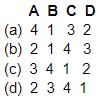Test: Class 10 General Science NCERT Based - 2 - UPSC MCQ
25 Questions MCQ Test - Test: Class 10 General Science NCERT Based - 2
Regarding the covalent bonds, which of the following statements is/are incorrect?
1. Bonds which are formed by the sharing of an electron pair between two atoms are known as Covalent Bonds.
2. Covalently bonded molecules are seen to have weak bonds within the molecule, but intermolecular forces are large.
3. Covalent compounds are poor conductors of electricity.
Which of the following structures are allotropes of carbon?
1. Diamond
2. Graphite
3. Fullerene
Select the correct answer using the code given below:
Regarding ethanol, which of the following statements is incorrect?
With reference to alcohol, consider the following statements:
1. Sugarcane juice can be used to prepare molasses which is fermented to give alcohol (ethanol).
2. Alcohol can be used as an additive in petrol since it is a cleaner fuel.
Which of the statements given above is/are correct?
Which of the following elements are responsible for the hardness of water?
Match List-I with List-II and select the correct answer:
List-I (Scientist)
A. Johann Wolfgang Döbereiner
B. John Newlands
C. Dmitri Ivanovich Mendeléev
D. Henry Moseley
List-II (Work/theory)
1. Law of Octaves
2. Coined the term ‘Triads’
3. Modern Periodic Table
4. Early development of the periodic table of elements.

With reference to Mendeléev’s Periodic Table, consider the following statements:
1. Mendeléev arranged the elements in the order of their increasing atomic masses.
2. Mendeléev left some gaps in Periodic Table
Which of the statements given above is/are correct?
Regarding the limitations of Mendeléev’s classification, consider the following statements:
1. The Position of Hydrogen was ambiguous.
2. Isotopes of all elements posed a challenge to Mendeleev’s Periodic Law.
3. The atomic masses do not increase in a regular manner in going from one element to the next.
Which of the statements given above is/are correct?
Regarding the modern periodic table, consider the following statements:
1. Properties of elements are a periodic function of their atomic number.
2. There are 7 groups and 18 periods.
Which of the statements given above is/are correct?
Regarding the modern periodic table, which of the following statements is incorrect?
Match List-I with List-II and select the correct answer:
List-I (Plant hormones)
A. Auxin
B. Gibberellins
C. Cytokinins
D. Abscisic acid
LIST-II (Effects)
1. Promote cell division
2. Inhibits growth
3. It helps the cells to grow longer
4. Help in the growth of the stem
Consider the following hormones:
1. Adrenaline
2. Testosterone
3. Estrogen
Which of the above hormones, prepare the human body for fighting or running instantaneously?
Consider the following pairs:
1. Thyroid Gland: Thyroxine hormone
2. Pituitary Gland: Growth hormone
3. Pancreas: Insulin
Which of the pairs given above is/are correctly matched?
Consider the following statements:
1. Voluntary actions are controlled by Hindbrain.
2. Hearing, Smell is controlled by Fore-Brain.
Which of the above statements is/are Correct?
Consider the following pairs:
1. Benzoic acid formed in our muscles during a physical activity leads to cramps.
2. The rate of breathing in aquatic organisms is much faster than that in terrestrial organisms.
Which of the statements given above is/are correct?
Consider the following statements:
1. Plants store carbohydrates in the form of glycogen.
2. Human beings store carbohydrates in the form of starch.
Which of the statements given above is/are incorrect?
Consider the following events about Photosynthesis:
1. Absorption of light energy by chlorophyll.
2. Reduction of carbon dioxide to carbohydrates.
Which of the statements given above is/are correct?
Consider the following statements about Digestion:
1. The secretion is done by the small intestine.
2. Hydrochloric acid inhibits the functioning of Pepsin.
3. The Mucus protects the inner lining of the stomach from the action of the acid.
Select the correct answer using the code given below:
With reference to the respiration in human beings, consider the following statements:
1. Cartilage blocks the air passage.
2. Haemoglobin has a very high affinity for oxygen.
3. Fine hairs in the nostril traps harmful microbes in respiration.
Which of the statements given above is/are correct?
Regarding blood pressure, consider the following statements:
1. The Blood pressure is higher in Veins than in Arteries.
2. The normal systolic pressure is about 120 mm of Hg and diastolic pressure is 80 mm of Hg. 3. Blood pressure is measured with an instrument called sphygmomanometer.
Which of the statements given above is/are correct?
Regarding 'reproduction', consider the following statements:
1. The basic event in reproduction is the creation of a DNA copy.
2. Two copies of DNA in a reproducing cell are completely identical to each other.
3. Reproduction is linked to the stability of the population of species.
Which of the statements given above is/are correct?
With reference to the male and female gametes, consider the following statements:
1. A female gamete is smaller than a male gamete and likely to be motile.
2. Male gametes are large and contain food-stores.
Which of the statements given above is/are correct?
With reference to the reproductive parts of flower, consider the following statements:
1. Stamen produces pollen grains.
2. The Swollen part of Carpel is known as ovary.
3. Cross Pollination involves transfer of pollen grains to the same flower.
Which of the statements given above is/are correct?
Regarding the male reproductive system, consider the following statements:
1. Sperm formation requires a higher temperature than the normal body temperature.
2. Testosterone triggers Changes at Puberty.
Which of the statements given above is/are correct?
Regarding the female reproductive system, consider the following statements:
1. Fertilization takes place in the female's Uterus.
2. The embryo gets nutrition from the mother’s blood with the help of a special tissue called placenta.
Which of the statements given above is/are correct?














